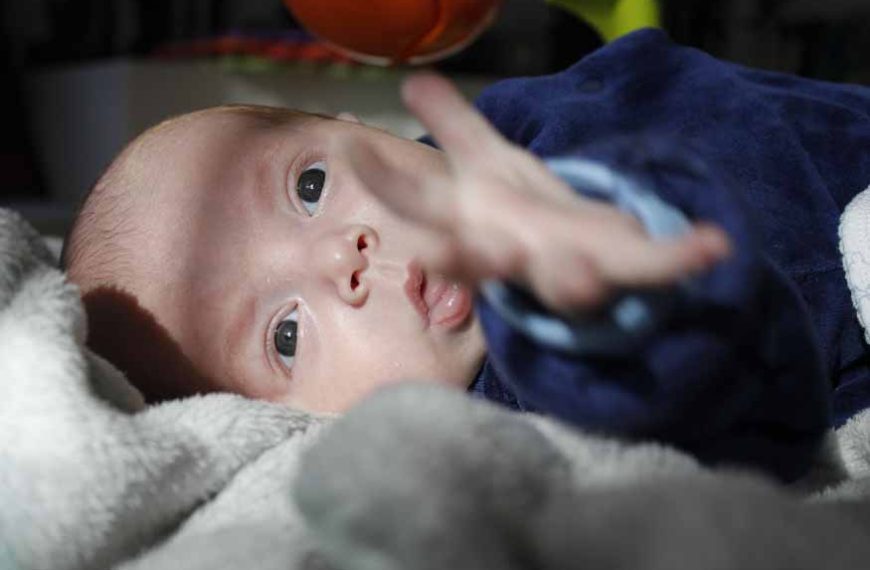That moment when you held your little bundle of joy for the first time ever when she wrapped her tiny fingers around yours and looked into your eyes! Fewer things can be as unique as that moment, isn’t it? Understanding infant vision development is key to nurturing your baby during these early stages.
The First Glimpses: When Does the World Come into Focus?
So, when do babies start seeing clearly? Unlike hearing or touch, which are more developed, their eyes are just starting to learn how to see. During the early days, your baby’s world is a bit fuzzy. Within the first week, they can focus on objects close-up, about the distance from their parent’s arms to their face – perfect for those first memorable eye contacts.
A World in High Contrast: Understanding Newborn Eyesight
The initial phase of your baby’s eyesight is all about high contrasts. This is a crucial stage in the infant vision development timeline. Interestingly, in our vibrant Indian culture, where colors play a significant role, your newborn sees these stark contrasts better. That’s why traditional Indian toys and baby items often feature bold, contrasting patterns – they’re beautiful and beneficial for your baby’s developing eyes!
Watching Them Watch the World: Infant Vision Development Timeline
Your baby’s eyesight is growing every second.
- After two months, watch as they start to follow objects and reach out, trying to grasp the world. These early stages are critical in the infant vision development timeline, allowing parents to engage with their babies through playful activities like moving toys and soft, soothing games.
- By four months, their world starts to gain depth, quite literally, as they begin to perceive things in 3D.
- By six months, they’ll start recognizing familiar faces – yes, they’ll know you, their loving parent!
- And by their first birthday, their vision is nearly as clear as yours, though it will continue to sharpen until they’re about five.
Baby Diet and its Impact on Vision
The journey to robust and healthy vision starts from their first sips and bites. This is where understanding newborn eyesight and its dietary needs becomes important.
- Breastfeeding and Infant Formula
- The Next Step: Introducing Solids
- Sometimes, a Little Extra: Supplements
Breastmilk can be excellent for your baby’s vision apart from her overall growth. However, you don’t need to fret if you are not breastfeeding or feeding breastmilk. Today’s infant formulas are doing a pretty impressive job. They’re often enriched with DHA and ARA, ensuring your baby doesn’t miss out on these critical nutrients for eye health.
Slowly, as you start solids for your baby, some food items have nutrients that can aid eye health. For example, vegetable and leafy vegetables like carrots, spinach, etc can provide a truckload of nutrition, which can be super important in your child’s vision development.
Typically, your baby’s food has enough nutrition to care for her eye health. Nothing additional is needed. However, in certain situations or if a dietary restriction is made, you can give supplements based on your pediatrician’s and ophthalmologist’s advice.
Clearing the Air: Busting Myths About Baby Eyesight
Even in this day and age, there are no shortage of myths about baby eyesight. Let’s set the record straight on a few of these:
- The Kajal Conundrum
- The TV Tale
- Crossing Eyes: A Passing Phase
- The Carrot Myth
It’s almost a ritual in many Indian homes – lining those adorable baby eyes with kajal. The belief? It’ll sharpen their vision or make their eyes appear more prominent and more striking. Here’s the reality check – it’s a myth. Kajal, especially the traditional homemade kind, might carry contaminants that could harm those delicate eyes, causing infections or allergies.
Does this line sound familiar? “This TV is going to ruin your eyes!” Every parent reading this must have heard this from their parent. While gluing to the screen for too long can strain those little eyes, causing fatigue, it will not damage their vision permanently. The real deal is to balance screen time with plenty of physical play and rest. One should avoid screen time until the child is at least 4 years of age and post that to limit it to a maximum of 20 minutes in a day at a stretch.
Now and then, you might catch your baby with crossed eyes, and it’s enough to make any parent a tad nervous. Here’s some reassurance – it’s usually just a part of their visual development. But, if you notice it’s a constant thing, a quick chat with the doctor is a good idea. Early intervention can work wonders.
There is the age-old tale – eat carrots, and you’ll ace those night missions like a superhero. That is just not true. Only a diet with various fruits and veggies is your best bet for keeping those little eyes healthy. We all must have heard this from our parents and grandparents – if you eat carrots, you’ll have no vision problem or even better. This is a super myth. No vegetable has that superpower. So, add all types of vegetables and fruits to your little one’s diet.
Do’s and Don’ts in Indian Homes:
- Do’s:
- Encourage with Colors: Engage them with high-contrast toys and books.
- Health Check-ups: Regular eye check-ups are a must.
- Explore the Distance: Let them look around at different distances.
- Don’ts:
- No Kajal or Surma: Though traditional, avoid applying these to your baby’s eyes as they can cause harm.
- Limit Screen Time: Keep those mobile screens away; their bright lights aren’t good for your little one’s eyes.
- Shield from Harsh Sun: Their delicate eyes need protection from direct sunlight.
A Newborn’s Perspective: What Can They See?
Did you know? Your newborn predominantly sees the world in black and white, leaning towards high-contrast patterns. It’s because their color vision has yet to fully develop. The American Academy of Ophthalmology says they can make large shapes and faces, and this vision gradually improves.
As we conclude our exploration of your baby’s vision development, let’s appreciate the broader journey. From their initial blurry glimpses to the eventual sharp, curious looks that follow you, each stage in your child’s visual growth deepens their understanding of the world. Let’s treasure it.
For more such informative blogs, visit us at EuroKids
















